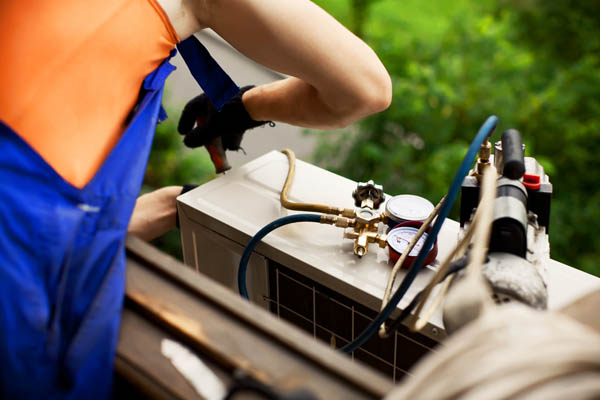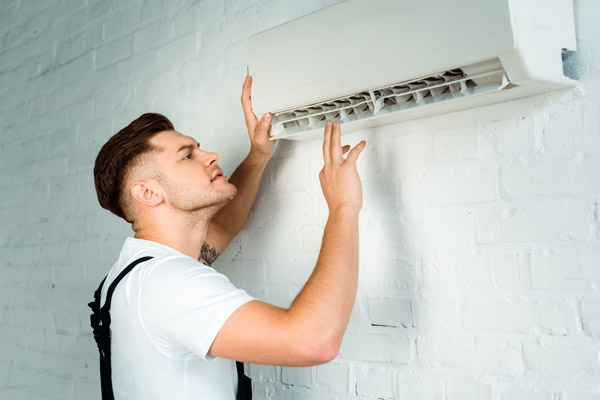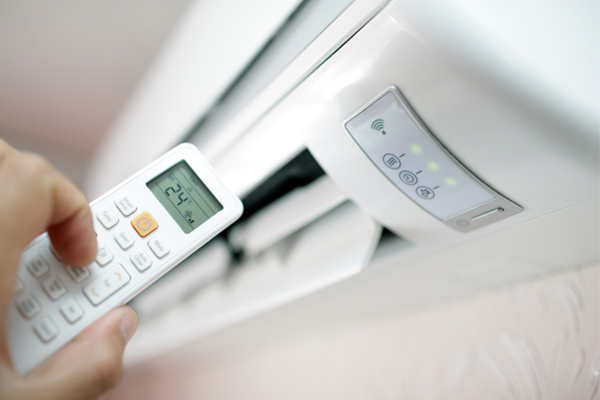
If you are thinking about installing a ductless mini-split system, choosing the correct-sized mini-split unit for your house is one of the most critical steps. Ductless mini-split systems are one of the most efficient HVAC systems due to inverter technology. This type of technology allows your mini-split system to generate only a sufficient amount of heating or cooling to maintain your temperature requirements.
Although mini-splits possess this specific technology, it is still important that you size the unit correctly for your living space. In this article, we share a ductless mini-split sizing guide to help you out.
Why Is It Crucial to Properly Size My Mini-Split Unit?
Contents

It is essential to properly size a mini-split because your comfort and energy savings are on the line. A correctly-sized system will effectively and efficiently heat or cool your home. Because of this, you must install a mini-split system with a BTU rating that is appropriate for your specifications and needs.
BTU (British Thermal Unit) & Its Application For A Ductless HVAC System
BTU, or British Thermal Unit, is the thermal energy measurement. It measures the amount of heat needed to increase the temperature of a pound of water in increments of one degree Fahrenheit. That means that one BTU is equivalent to the power needed to heat or cool a single pound of water by 1 degree Fahrenheit.
Generally, the bigger the room, the higher the BTU rating your mini-split unit will require. A mini-split system can have a BTU rating as high as 56,000 BTU or as low as 6,000 BTUs. When you are deciding on a mini-split in relation to the BTU rating requirements of your house, keep in mind that the heating capacity of these units is slightly higher than their cooling capacity.
It is also important to note that your mini-split system should not be too big or too small for the area you want to cool or heat. If that happens, there will be unwanted effects that will interfere with your daily comfort and your mini-split unit’s functionality overall.
A Mini-Split That Is Too Small

If your mini-split unit is too small, it will result in an uncomfortable and inefficient home. The unit will run continuously, but it will not be able to effectively condition the space that it needs to. You will waste energy because you won’t be able to fully feel the heating or cooling power of the unit. This insufficient heating or cooling will lead to cold or hot spots because the preferred temperature won’t reach every section of the zone.
In addition, a mini-split unit that is too small tends to work longer and harder to compensate for its inadequacy. Therefore, your unit will become aged and wear out quicker than it should. In doing so, it increases the possibility of the mini-split breaking down. Moreover, the longer your mini-split unit runs, the higher your bills for utilities will get too.
Bigger Is Not Always Better
Just because a mini-split is bigger, it doesn’t necessarily equate to a better choice. First of all, when you buy a mini-split unit that is too large, you will spend more money on equipment. Basically, this negates any savings on the energy you will make.
Secondly, if a mini-split unit is too big for the zone it is cooling or heating, it will result in short cycling. This is when your system continuously turns off and on in a short period of time. A unit that short cycles will also result in quicker wear and tear. Because of this, your mini-split system is likely to malfunction regularly, and this can also lead to early failure.
Finally, your mini-split unit also works as a dehumidifier. Unfortunately, a mini-split system that is too large and continuously short cycling will not be able to get rid of humidity correctly. As a result, your home will feel damp and humid.
How To Determine The Size Of Your Mini-Split Unit

When choosing a mini-split unit for your house, your size considerations should include how large or small the living space is for a single-zone configuration or how large or small each living space is for a multi-zone application. The outdoor compressor might have a different size, but one that complements every indoor unit installed in separate zones within your house. Each room in your house most likely has a different size. Thus, each indoor air handler’s BTU rating will also be different.
Remember that it is always best to get a professional HVAC contractor to assist you in determining the proper ductless mini-split size that you require. A technician who is an expert might take the following steps to determine a standard estimate of the proper mini-split unit size:
- Establish the square footage of each room. An expert will measure the length of the room by the width and multiply those numbers. For instance, if the living space is 30 feet in length and 40 feet in width, then 30 feet times 40 feet equals 1,200 square feet.
- To get the estimated BTU rating, the contractor will take the square footage of the living space and multiple it by 25. For example, 1,200 square feet times 25 equals a BTU rating of 30,000.
This calculation is appropriate for rooms that are rectangular in shape. Other common room shapes include circular and triangular. An expert can assist you no matter what type of room shapes you have. For this reason, it is always a sound idea to get in touch with a local reputable HVAC technician to assist you in determining the correct mini-split size that is suitable for each room in your house.
This chart details the approximate BTU ratings for various sizes of mini-split units:
Ductless Mini-Split Sizing Chart
Conditions That Affect Mini-Split Sizing
Remember that even though the size of a room can affect the BTU capacity you require significantly, it is not the only determining factor. The conditions of the environment and other factors that are external also contribute to determining the correct size of the mini-split unit you require.
Outside Climate
The outside climate can affect indoor temperature. Your mini-split unit can be sized differently depending on whether you live in an area with colder or hotter weather. For example, if you live in an area that frequently experiences temperatures over 90 degrees Fahrenheit, then the system you purchase should have a BTU rating with at least a 30 percent increase.
Insulation and Age
Your home’s age is a factor because homes that are newer generally have insulation that is better than the insulation in older homes. This is because the building codes have been revised. If you live in a home that is older and has poor insulation, it will need more power to heat or cool. You need to increase the BTU rating by at least 30 percent in order to be comfortable. On the other hand, you will require fewer BTUs if you live in a newer home with appropriate insulation.
Height Of The Ceiling
Room size is affected by high ceilings because they make the rooms bigger. The average ceiling height in most houses is eight feet high. If your ceilings exceed that height, then you are recommended to increase BTU capacity by at least 20 percent in the mini-split unit you will buy.
Additional Factors
Some of the other factors that determine the calculation of the BTU load in your house include:
- Doors And Windows: The BTU load is affected by the number of doors and windows in the zone where you will place your mini-split unit because these areas are not insulated. Because of this, the small gaps and cracks in your windows and doors can leak air.
- Full Sunlight: A room is heated by direct sunlight. Figure out how much direct sunlight enters a room because this can affect what size of mini-split unit you need for the room.
- The Kitchen: If you want to place a mini-split unit in the kitchen or a room that is nearby the kitchen, then you may require a larger sized mini-split unit so that you can cool the room adequately. The reason for this is that kitchens are spaces that are open and they have appliances that emit heat such as stoves and ovens.
- Number Of People: Every person generates heat, and this can affect the mini-split size that you require. Because of this, you need to determine how many occupants will usually be in the room you want to place the equipment in.
- Lighting: Lightbulbs are another source of heat, and some lightbulb types generate more heat than the others. Therefore, a room that has multiple lightbulbs will affect the size of the unit you need.
- Flooring: A carpeted floor is better insulated than a floor that is only hardwood. Therefore, this could affect the mini-split unit size requirements for that room.
Conclusion
Determining the proper size of the mini-split unit your home needs is done with a load calculation process. This establishes the correct amount of cold or warm air that an area requires to ensure the temperature in that area is comfortable and constant.
You can find load calculators on the internet. But if you want a more accurate size calculation, it is best to discuss it with an expert. Your local qualified HVAC technician can guarantee you a professional and complete sizing for your home and assist you with getting the specific product your house requires. Likewise, they can perform a ductless installation to ensure safe and efficient operation.
Check Out One Of Our Ductless Installation Projects
Mitsubishi Ductless Installation Project In Rocky Hill, New Jersey
Call PFO Heating & Air Conditioning To Learn More About Ductless HVAC Systems
 Interested in learning more about ductless HVAC systems? For all your HVAC system needs, call PFO Heating & Air Conditioning today. Our technicians are all professionally certified, and they have a great deal of experience. They’ll also determine what your home comfort needs are and find the best and most affordable solutions to meet them.
Interested in learning more about ductless HVAC systems? For all your HVAC system needs, call PFO Heating & Air Conditioning today. Our technicians are all professionally certified, and they have a great deal of experience. They’ll also determine what your home comfort needs are and find the best and most affordable solutions to meet them.
As a full-service HVAC company, PFO Heating & Air Conditioning offers an array of HVAC services. This includes heating and cooling installations, tuneups, repairs, and much more. We offer free, in-home consultations. Call now to schedule an appointment.
Click here to contact us now or call us at (800) 253-9001 to find out more!



